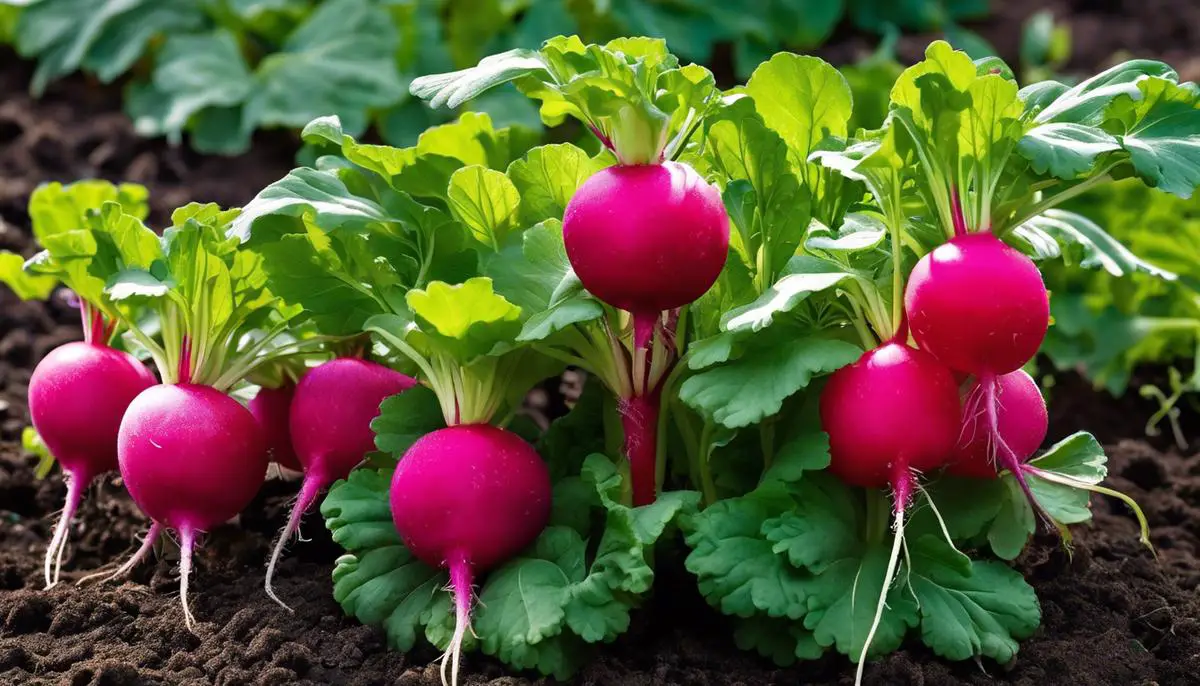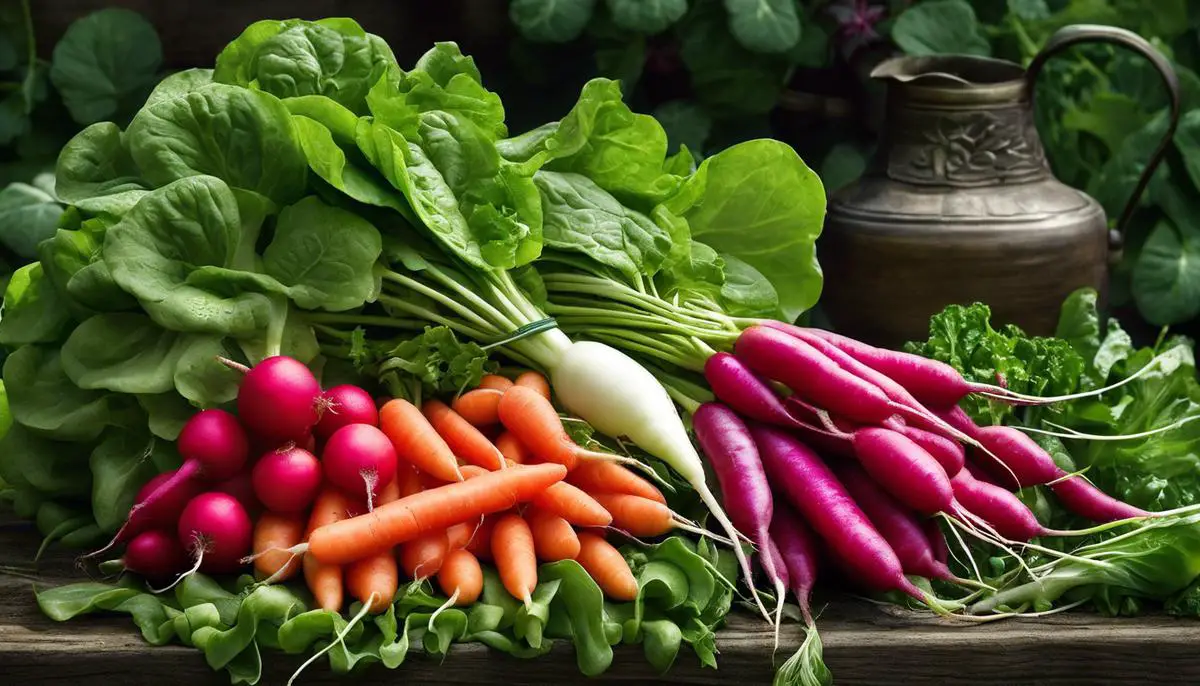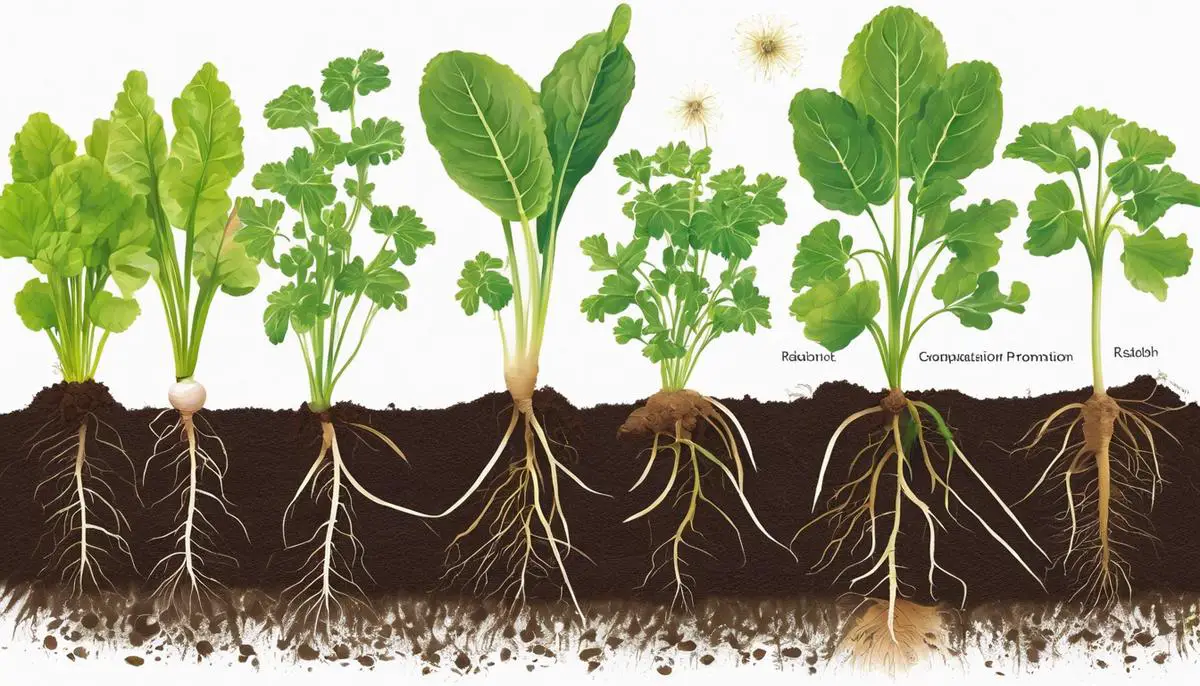Harmonious growth in a garden is everybody’s aim, and one fascinating way of achieving this is through companion planting. This idea revolves around planting diverse crops in proximity to each other to reap mutual benefits. Among the veggies that respond exceptionally well to this strategy are radishes. To explore their potential companions, we need to first lay the groundwork by comprehending the basic growth requirements and peculiarities of the radishes. Subsequent to that, we will delve into the merits of companion planting for radishes, showcasing some practical examples and case studies to illustrate these benefits. Furthermore, we will unveil a list of select plants that make the best companions for radishes, explaining how each one contributes to their mutual growth. Lastly, to practically apply these findings, we’ll provide a comprehensive guide on planting radishes with their beneficial buddies emphasizing optimal planting times, watering schedules, care tips and much more.
Understanding Radishes
A radish is a superb addition to any gardening enthusiast’s arsenal. They’re crisp, vibrant, and provide a zesty tang to fresh salads. Plus, who can resist the palate-cleansing kick that comes from biting into an organically home-grown radish? Growing them can be quite complex, although rewarding. Certain characteristics make them more or less suitable to companion planting, a methodology that is prevalent amongst green-thumbed enthusiasts.
Reader Poll: What online courses would interest you?
If it’s an attempt to better understand the growth characteristics of radishes, and their influences on compatible planting, then you’ve come to the right place. Let’s go ahead and dive in.
First and foremost, radishes are a cool-season crop and thus, prefer the cooler temperatures of spring and fall. They love sun; a full six to eight hours a day is perfect, so they’re less suited to growing alongside crops which require more shade.
Radish plants are robust growers! From seedling to harvest, the lifecycle of a radish is a short one, typically averaging about 20-30 days. This fast turn-around time means they can be inter-planted with slower-growing crops without much overlap in harvest times. Consider companion planting with vine crops that take longer to mature, such as cucumbers or squash, and that can utilize the vacated space once the radishes are harvested.
Subscribe to our newsletter!
Watering is a paramount concern when it comes to radishes. They are fans of regular watering. Keep the soil evenly moist but not saturated, to keep them growing robustly and without interruption.
A fascinating characteristic of radishes is their pervasive root system which, depending on the variety, can go more profound and more extensive than some might realize. They are known to break up the soil helping to circulate oxygen and nutrients, leading to improved soil health and structure. This becomes beneficial when paired with plants whose root networks are more compact or shallow, like lettuce or spinach.
Lastly, radishes can play a critical role in pest management. They are known to deter many types of insects, like aphids and cucumber beetles. Thus, planting them alongside vulnerable crops can be an effective, natural pest deterrent method.
Remember, while these guidelines provide essential insights into radish growth characteristics, there is no substitute for hands-on experience. A green thumb is not something you’re born with – it’s something you grow! Happy gardening!

Benefits of Companion Planting
Growing radishes in harmony with other plants — a delightful concept known as companion planting— offers a plethora of benefits. It might seem like magic, but it’s really just science!
In essence, companion planting is the clever practice of growing certain plants in close physical proximity, often because they’re observed to enhance each other’s growth and overall vigor. The simple radish, often underestimated, serves as a masterful partner in this intricate dance, its unique botanic properties benefiting various gardening comrades.
One commendable trait of radishes is their ability to function as bio-drills. Their stout roots penetrate compacted soil, creating channels that facilitate the flow of water, nutrients, and air – crucial elements that foster optimal growth. This symbiotic relationship allows neighboring plants, particularly those with weaker, more delicate root systems, to flourish too.
Furthermore, radishes are an excellent accompaniment to legumes. Beans, peas, and lentils, for instance, contain beneficial nitrogen-fixing bacteria in their root nodules. Radishes, with their deep roots, mine nutrients from the soil depths and, in turn, help the legumes by making those nutrients more accessible.
Radishes are also quite a powerhouse when it comes to pest management. Their pungent smell and distinct flavor are excellent deterrents for many harmful insects and pests. By inter-planting radishes with susceptible plants, like squash and cucumbers, it can help safeguard these favorites from damaging nematodes and beetles.
Intriguingly, radishes can also act as a sacrificial crop. This means they’re fast-growing, easy to harvest, and can be used to “trap” pests away from other, more valuable crops. If the pests are munching on the radishes, they’re less likely to bother other nearby plants.
Companion planting with radishes can also aid in fooling or deterring weed growth. Radishes grow rapidly, their lush, leafy green tops can shade the soil, preventing the sprouting of unwanted plants. Less competition for nutrients means healthier, more robust vegetable crops.
Lastly, radishes act as an excellent catch crop. Due to their rapid growth rate, they can be grown between rows of slower-maturing plants, making full use of available space. They can also be harvested before the main crop is ready, preventing waste and promoting a continuous supply of fresh produce.
In conclusion, planting radishes in companionship with other plants isn’t just great for the radishes. It’s a beneficial relationship for the entire vegetable garden, underscoring the majesty of Nature’s intricately interconnected web. There’s no downtime with radishes – they’re always working, always providing, always contributing. Quite the dependable garden ally, wouldn’t you agree?

Best Companion Plants for Radishes
Now, let’s turn to the best companions for our robust radishes. Recognize, however, that not all companions are equal and some pairing combinations will vary depending on regional or microclimate conditions.
For a grand start, beans are a fantastic complement for planting with radishes. Beans fix nitrogen into the soil which radishes can readily use to thrive. Moreover, the tall growth of bean stalks provides shade – helping radishes to keep their cool (a necessity as earlier noted), while radishes’ rapid growth deters weeds that may compete with young bean plants.
Added to beans, radishes also pair well with leafy vegetables like lettuce or spinach. The potent radish scent aids in keeping pests off tender leafy greens. Plus, the shallow root system of these salad staples don’t interfere with the deeper spread of radish roots.
Peas are also beneficial – like beans, they fix nitrogen in the soil aiding the radishes to flourish. There’s an added bonus here as radishes help deter the likelihood of destructive pests (like aphids) from harming pea plants.
Cucumber plants also make excellent companions for radishes. Cucumbers attract some specific pests that radishes can help ward off, safeguarding cucumber plants while enabling radishes to grow unhampered.
Carrots are another suitable companion for radishes. Both prefer a similar depth of planting, and radishes can help break up the soil, making it easier for carrot roots to penetrate the ground. Also, radishes mature much faster than carrots, allowing radishes to be harvested before carrots need more space.
Conversely, radishes are known to be competitive or detrimental to some plants, particularly those in the Brassica family, including kale, cabbage, broccoli, and Brussels sprouts. Radishes can attract flea beetles and root maggots, problematic pests for these Brassica plants.
Last but not least, radishes make good friends with beneficial insects. Flowering radishes will attract pollinators such as bees, while their pungent smell can deter many harmful insects.
The flexible radish can play a multitude of roles in a shared planting space – acting as a protector, soil enhancer, or an avenue for maximizing harvests. By making smart planting decisions, this humble root vegetable can truly transform the dynamics of your garden. Reap the rewards of companion planting and see radishes thrive!

Planting guide and Care tips for Companion Plants
When it comes to optimizing the growth and yield of radish crops, understanding the concept of companion planting is key. Certain plants adjacent to radishes help them thrive and vice versa. Usually, nutrient requirements, growth habits, or pest-control characteristics of these companions play a significant role in this synergy.
Beans and peas are often touted as the best companions for radishes. Their longer growth periods complement radishes’ quick growth cycle, allowing enthusiasts to harvest radishes without disturbing the growth of beans or peas. Further, legumes enrich the soil with nitrogen which is essential for radishes. Interestingly, cucumbers also partner well with radishes, as they help deter beetles which the cucumber plant is usually vulnerable to.
While discussing companions, how can we forget about leafy vegetables? Lettuce and spinach make an excellent pair with radishes for a few reasons. Radishes grow deeper into the soil, letting shallow-rooted lettuce or spinach utilize the topsoil’s nutrients optimally. Plus, radishes mature faster than most leafy greens, providing natural shade cover for the slower growing greens during the hot summer months. Carrots, too, are great associates as radishes help them by breaking up the compacted soil with their robust root system.
However, not all plants get along with radishes. Cabbage, kale, broccoli, and Brussels sprouts should ideally be planted away from radishes as they all are prone to similar pests. Placing them together increases the risk of an all-out infestation.
Now, let’s explore an overlooked advantage of radishes. They’re favored by certain beneficial insects due to their soft, succulent leaves and nectar-rich flowers. Insects like lacewings, hoverflies, or ladybugs feed on pests like aphids, mites, or smaller insects, indirectly acting as a natural pest control system.
A garden filled with radishes is versatile and full of potential. The ability of radishes to improve soil health, as mentioned earlier, and act as a catch crop and weed control, makes them an asset in achieving an efficient garden. With a bit of planning and good plant companions, growing radishes can be a joy and a great way to maximize the potential of a home vegetable patch. Surely, nothing beats those crisp, home-grown, juicy radishes in salads, bringing a dash of freshness and zest to your plate. Happy gardening!

Ultimately, the wealth of a garden isn’t measured only in its bounty, but also in the harmony its inhabitants share. The art of companion planting enables gardeners to tap into this symbiotic essence of nature, creating ecosystems that are resilient, self-sustaining, and prolific. When it comes to radishes, their simple demands yet pronounced benefits make them a prime candidate for companion planting. By pairing radishes with the suggested companion plants, their growth can be significantly enhanced, and their pest resistance boosted, all while contributing to the overall harmony of the garden. This guide serves to inform and inspire home gardeners to venture into companion planting, arming them with the necessary knowledge to make informed decisions and practical tips to make the most out of this strategy. Remember, a garden is a grand teacher. It teaches patience and careful watchfulness; it teaches industry and thrift; above all it teaches entire trust. Happy gardening!

